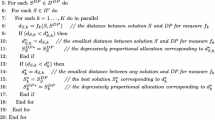Abstract
Although proportional allocation methods are well-known and widely used in the parliamentary tradition, they cannot be applied in a wide variety of cases. Such problems occur in the European Parliament, where a constitutional principle is to assure that less populous countries will not be dominated by the others, which implies that allocations have to be degressively proportional. However, under this assumption an exhaustive search of the solution space is intractable. To solve the problem, the Cambridge Compromise algorithm was proposed, which is durable, transparent, impartial to politics and unambiguous, but the allocations obtained are not degressively proportional. Therefore, we propose an allocation algorithm derived from operations research that inherits the transparency of the Cambridge Compromise and produces an unambiguous degressively proportional allocation. Hence, the paper aims at testing our alternative allocation method and comparing its outcomes during computational analysis.
Similar content being viewed by others
Notes
Note that Clara, from Latin Clarus, means clear, which in our case is interpreted as a method that is transparent and impartial to politics.
References
Avery G (2014) Independentis and the Europran Union. Europan Policy Centre, Brussels
Bautista J, Companys R, Corominas A (2001) Solving the generalized apportionment problem through the optimization of discrepancy functions. Eur J Oper Res 131:676–684
Dniestrzański P (2014) Proposal for measure of degressive proportionality. Procedia Soc Behav Sci 110:140–147
European Union (2007) Treaty of lisbon. Off J Eur Union 50(C 306/1)
European Union (2012) Consolidated version of the treaty on European union. Off J Eur Union 55(C 326/01)
Florek J (2012) A numerical method to determine a degressive proportional distribution of seats in the European Parliament. Math Soc Sci 63:121–129
Grimmett GR (2012) European apportionment via the Cambridge compromise. Math Soc Sci 63:68–73
Gualtieri R, Trzaskowski R (2013) Report on the composition of the European Parliament with a view to the 2014 elections (2012/2309(INI)), pp 8–9
Lamassoure A, Severin A (2007) European Parliament resolution on “proposal to amend the treaty provisions concerning the composition of the European Parliament”, 2007. adopted on 2007-10-11 (INI/2007/2169)
Lauwers L, Van Puyenbroeck T (2006) The Hamilton apportionment method is between the Adams method and the Jefferson method. Math Oper Res 31:390–397
Łyko J, Rudek R (2013) A fast exact algorithm for the allocation of seats for the EU Parliament. Expert Syst Appl 40:5284–5291
Marshall AW, Olkin I, Pukelsheim F (2002) A majorization comparison of apportionment methods in proportional representation. Soc Choice Welf 19:885–900
Martínez-Aroza J, Ramírez-González V (2008) Several methods for degressively proportional allotments. A case study. Math Comput Model 48:1439–1445
Pukelsheim F (2014) Proportional representation: apportionment methods and their applications. Springer, Cham
Serafini P (2012) Allocation of the EU Parliament seats via integer linear programming and revised quotas. Math Soc Sci 63:107–113
Słomczyński JW, Życzkowski K (2012) Mathematical aspects of degressive proportionality. Math Soc Sci 63:94–101
Te Riele HJJ (1978) The proportional representation problem in the second chamber: an approach via minimal distances. Stat Neerl 32:163–179
Young HP (1994) Equity: in theory and practice. Princeton University Press, Princeton
Acknowledgements
We are grateful to the Editor and the Referees for their valuable comments on an earlier version of our paper. The results presented in this paper have been supported by the Polish National Science Centre under Grant No. DEC-2013/09/B/HS4/02702.
Author information
Authors and Affiliations
Corresponding author
Rights and permissions
About this article
Cite this article
Cegiełka, K., Łyko, J. & Rudek, R. Beyond the Cambridge Compromise algorithm towards degressively proportional allocations. Oper Res Int J 19, 317–332 (2019). https://doi.org/10.1007/s12351-017-0292-y
Received:
Revised:
Accepted:
Published:
Issue Date:
DOI: https://doi.org/10.1007/s12351-017-0292-y




